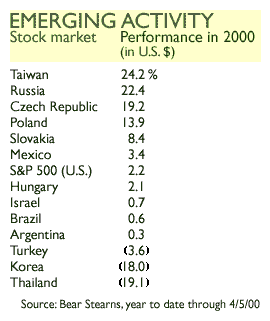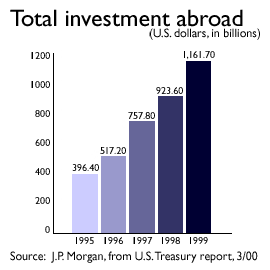|
Stay an emerging course
|
 |
April 10, 2000: 6:07 a.m. ET
After years of keeping money at home, U.S. investors are looking overseas
By Staff Writer Alex Frew McMillan
|
NEW YORK (CNNfn) - The first quarter of 2000 set a record for U.S. money moving into international and globally oriented mutual funds. Americans sent nearly $2.5 billion a week abroad, according to figures from J.P. Morgan.
To put that into perspective, the rate was about $700 million a week the previous quarter, the fourth quarter of last year. And that was the strongest quarter for money moving abroad since the Asian crisis and the second quarter of 1997.
Some analysts believe it's not a bad idea to invest some money in other sections of the world, especially when U.S. markets look choppy. But for most of the second half of the '90s, American investors were content to park their money domestically.
A renewed appetite for risk
However, in 1999, many international markets outdid U.S. performance -- the developed countries of Europe, Australia and the Far East beat out the S&P 500 in 1999, for instance. Many analysts expect other markets to continue to outperform this year, particularly the less-developed emerging markets.
 Which markets look most attractive in 2000? Asia has some very attractive values, according to Tom Van Leuven, global equity market strategist with J.P. Morgan. Latin America looks pretty good in a rich world, too, he said, though maybe not quite as attractive. Which markets look most attractive in 2000? Asia has some very attractive values, according to Tom Van Leuven, global equity market strategist with J.P. Morgan. Latin America looks pretty good in a rich world, too, he said, though maybe not quite as attractive.
Both Asia and Latin America offer greater earnings growth than the developed markets, Van Leuven says. And because investors got jittery in the late '90s and pulled out, he believes those regions offer good value, too. "That combination ... makes them more attractive than developed markets as a whole," he said.
Which way to turn?
Specific nations are harder to identify, given lurking political, economic and social problems. David Chon, chief global emerging markets strategist at Bear Stearns, looks for countries that have improving risk profiles. That often means an improving sovereign risk profile, or the rating given by credit agencies such as Moody's and Standard & Poor's to nations.
Specifically, Chon seeks countries that have governments working to restore confidence and maintain less volatile economies. His second criteria is proof those reforms are working. He looks for markets where inflation is declining and interest rates are falling or stable.
After so much money returned to emerging markets at the start of this year, the easy pickings have gone. "A lot of markets are up a lot from their lows," Chon said. "After the first three months of 2000, the extreme-distress value is no longer there."
"Going forward, it's going to be growth, and growth at a reasonable price, driving equity-price movements," Chon said. "Then you have to go further and say what is priced in or not priced in."
Not all markets are created, or priced, equal
He thinks Mexico, where the market is trading at a price-earnings ratio of 12 to 13, "has improved but is nowhere near where it should be." That makes it a great opportunity, he said. Particularly if it is elevated to investment-grade status by rating services, Mexico could move to P/E levels around 18 or 19 times earnings, he said.
 Chon thinks South Korea is also attractive. It is trading around 14 times earnings despite very strong earnings growth last year. "It's a sustained rapid expansion of profitability, yet the equity market is stuck," he said. "From a fundamental perspective, the market should be trading a lot higher." Chon thinks South Korea is also attractive. It is trading around 14 times earnings despite very strong earnings growth last year. "It's a sustained rapid expansion of profitability, yet the equity market is stuck," he said. "From a fundamental perspective, the market should be trading a lot higher."
He contrasted it with Taiwan, where the market is trading at 24 times earnings. Both countries produce similar goods, yet South Korea's trade and growth is stronger and Taiwan has political "overhang" from its testy relationship with China.
[One factor that may affect South Korea's economic growth is a potential thaw in its half-century standoff with communist North Korea. For details, click here.]
Taiwan falls into the group of countries that have improving profiles but have already benefited from renewed interest. Chon put Brazil, Argentina and perhaps Indonesia and Thailand in that category. "They have declining risk, but it's priced in. The return will be based on profitability growth there," he said.
It pays to be selective in investing in emerging markets, he said. Many investors used to set aside part of their portfolio and say, "Here's a chunk of money, get me everything." But that approach broke down in the Asian crisis.
Now investors are wise to pick and choose, Chon said. In fact, as emerging markets get integrated into global markets, many analysts say they are even moving away from the approach of looking simply at specific markets.
Playing sectors as well as markets
Instead, they look for sector plays, in many cases across several emerging markets. In Eastern Europe, for instance, "TMT" companies -- in technology, media and telecommunications -- are drawing a lot of attention.
Luke Spajic, local markets strategist for Lehman Brothers, said those communications industries, as well as industries such as chemicals and primary products, are more "transparent," easier to follow. Many companies in those industries are expanding beyond borders and stand to benefit from the "convergence" of Eastern Europe into Western Europe.
The most direct sector play is to invest in specific equities, Spajic explained. Telecommunications companies such as Matav in Hungary, Telekomunikacja Polska (or TPSA) in Poland, and Cesky Telecom -- formerly SPT Telecom -- in the Czech Republic are looked at as multinational communications plays like British Telecom, say, rather than just an emerging markets investment, he said.
By no means a sure thing
But investing in emerging markets is very different from investing in developed markets. While investors in developed markets expect their investments to grow if they stick with them long term, investors should not expect the same in emerging markets.
Studies on long-term performance have mostly been conducted in developed markets, "where you don't have foreigners stepping in with weapons," Spajic said. "Thinking 'Oh, put your money in a market and leave it for 30 years and you'll be fine,' that's not true."
Emerging markets are moving toward similar transparency, accounting values and shareholder treatment as developed markets. But they have a long way to go. In the meantime, "you have to be selective. It's a question of having these equities as a portion of your portfolio and a balanced portion of your portfolio," Spajic said.
Diversity through funds
High net worth customers invest directly and first in emerging markets, Spajic said, even before institutions. They tend to have the contacts and the first-hand business dealings to help them identify opportunities.
Those of less means likely need to select a good fund manager instead. Many investors who are self-directed in the United States favor mutual funds for emerging markets.
Jim Barnash, a certified financial planner with Lincoln Financial Advisors in Rosemont, Ill., likes to set aside 5 percent to 15 percent of his clients' portfolios for emerging markets, depending on age and risk tolerance. Longer-term investors get more exposure.
For younger investors with no time pressure, he also likes to set aside another 5 percent to 10 percent for general international investment.
That's substantially more international exposure than the 5 percent to 10 percent many planners recommend. The developed nations have the "old demographics," Barnash explained, so he thinks growth will be much more dramatic in emerging countries. He thinks it will come faster than it did in the developed world thanks to technological improvements.
"So especially with younger couples that are growing and raising their families, 25 percent in emerging markets and international I don't think is unreasonable," Barnash said. "Global exposure, you gotta have it."
Financial planners take the conservative route
He is very traditional in his approach, favoring the Templeton Emerging Markets fund (EMF) run by Mark Mobius. "It's my all-time favorite," Barnash said. "Here's a man that has invested his life in this."
Barnash also buys the AIM Developing Markets fund (GTDDX) and the AIM International Equity fund (AIIEX), which mixes emerging markets with "old-country" European markets. The AIM managers make more sector and momentum plays than Mobius, Barnash explained.
Barbara Steinmetz, a certified financial planner in Burlingame, Calif., puts between 10 percent and 12.5 percent of her clients' money abroad. She is leaning toward the high end of that range now.
She likes international funds such as Artisan International fund (ARTIX) and the Janus Worldwide fund (JAWWX). For emerging markets, she has been very pleased with the RS Emerging Growth fund (RSEGX), which she uses "with great consistency."
Picking specific markets is very hard, she said, which is why she leans toward broad international funds. She does have clients who invest directly in specific stocks. But that's best left for "discretionary" investing, what she jokingly calls "play money."
The big gainers make for interesting cocktail party conversation -- though Steinmetz pointed out people gloss over the losers. But mostly, investing in emerging markets is best done through a fund -- and for diversification, not conversation.
"Mutual funds are not exciting. They're basically dull," she said.
* Disclaimer
-- Click here to send email to Alex Frew McMillan
Got questions about financial planning? Need some advice? CNNfn.com has organized a panel of outside experts to answer your questions. If you want to be considered for our "Checks and Balances" column, where professional planners suggest ways you can manage your money, send us an e-mail at checksandbalances@cnnfn.com. Include information about your age, occupation, income and assets. Also, share with us any short-term and long-term financial goals you may have. And don't forget to leave your phone number. 
|
|
|
|
|
 |

|

